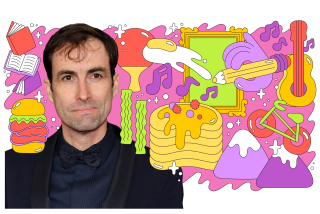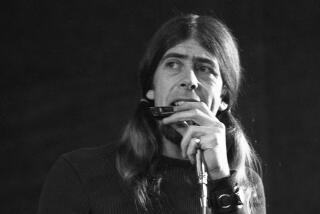A Look Back at the Blues
- Share via
Robben Ford, the renowned guitarist and now Ojai resident, has been making a name for himself with continuous touring and fairly regular recording throughout the 1990s. But there’s much more to the story.
In fact, Ford’s story goes way back to when he was a hot 18-year-old who moved out of his small Northern California hometown to San Francisco. There, he began to make waves playing with the Charles Ford Band (named after his musician father) and Jimmy Witherspoon. He came to Los Angeles, and the high-profile resume began: He joined Joni Mitchell’s band, did studio work, played with George Harrison, formed what would become the Yellowjackets, played with Miles Davis, etc.
Now, from deep in the Ford archives, comes the rough but engaging album, “Discovering the Blues,” released on the Avenue label. Recorded in 1972, live at the old Ash Grove in Los Angeles and the old Golden Bear in Huntington Beach, the recording nicely documents the rugged charms and bluesy surrender of Ford as a 21-year-old. This was before his name became noted in guitar circles and before he became a hit on pop radio with his famous solo on Mitchell’s “In France They Kiss on Main Street.”
Clearly, from the evidence here, Ford was discovering the blues with a passion, and had been for years already. The album starts out with the B.B. King tune, “Sweet Sixteen,” played with a scorching attack and slightly distorted tone, only five years after Ford himself was 16.
He also works out on John Lee Hooker’s “It’s My Own Fault” (featuring a long, heated, sculpted guitar solo before a tasteful electric piano solo by Paul Nagle) and Walter Jacobs’ “Blue and Lonesome.”
Ford started out on saxophone, which could explain the kind of breath-related phrasing he tends to issue on guitar, characteristic of his instrumental voice. He picks up a tenor sax to play a blues-doused version of the jazz standard “You Don’t Know What Love Is,” peeling off streams of notes and craggy, overtone-choked high notes that remind us of John Coltrane and/or Gato Barbieri.
But this band clearly is more comfortable in the bedrock of the blues, as is Ford. Even 25 years ago he had a signature way with a guitar pick--hard and soft simultaneously--and flung blues-laden innuendoes with the best of ‘em on his original “You Drive a Hard Bargain.”
These days, Ford is a smoother player, and his voice less edgy, as maturity has transformed his musicality. This vintage recording tells of passions and traditions that were absorbed long ago, when Ford was telling the blues with a gritty truth beyond his tender years.
*
Jazz at the Altar: The first phase of an enterprising jazz concert series wraps up this Sunday night at the eccentric architectural landmark now home to the Church of Religious Science. The series of “Sunday Evening Jazz Concerts,” nestled into this Mayan-influenced structure, closes its first trial month with an appearance by saxophonist Charles Owens, a fluid and versatile player with a resume that covers a surprising range.
Owens is one of those West Coast jazz players whose residency--not to mention his flexibility--in the music mecca of Los Angeles has led to a varied musical life. He played with Buddy Rich’s big band and Mongo Santamaria at the jazz end, but also worked with Diana Ross and Frank Zappa.
In addition, Owens has contributed to the music of some of L.A.’s most important cutting-edge jazz musicians, including the late, great clarinetist John Carter, flutist James Newton and pianist Horace Tapscott, a mainstay of L.A.’s jazz left for decades.
In Ventura, Owens will head a group featuring pianist Theo Saunders, bassist Louis Spears, and drummer Carl Burnett playing jazz in the presence of the mock altar.
The spirit is right, the venue is right: Hopefully, the series will continue.
* Charles Owens, 7:30 p.m. Sun. at Church of Religious Science, Santa Clara and Laurel streets, Ventura. Tickets are $12; (805) 642-4358.
*
Camerata Closer: Speaking of series coming to a juncture, the Camerata Pacifica (formerly Bach Camerata) is wrapping up the first season with its new moniker this weekend. By playing four locales in Santa Barbara and Ventura counties, this well-received, finely tailored ensemble is undoubtedly coming to a venue near you.
It has been another diverse several weeks of programming for the Camerata, from classical staples to the 20th century stuff of Witold Lutoslawski and George Crumb.
The final program, typically broad in scope, includes Leonard Bernstein’s Clarinet Sonata; Poulenc’s Sextet; a symphony, “Le Matin,” from Haydn; and, for good measure, the season’s token nod to the Camerata’s old name, Bach’s Trio Sonata in G, BWV 1038. Another good, compact season comes to an end, with high hopes for the future.
* Camerata Pacifica, tonight at the Music Academy of the West, 1070 Fairway Road in Santa Barbara; Friday at Santa Barbara City College; Saturday at Temple Beth Torah, 7620 Foothill Road, Ventura; and Sunday at Thousand Oaks Civic Arts Plaza, 2100 Thousand Oaks Blvd. Tickets are $22; $5 student rush tickets are available 10 minutes prior to each concert.
More to Read
The biggest entertainment stories
Get our big stories about Hollywood, film, television, music, arts, culture and more right in your inbox as soon as they publish.
You may occasionally receive promotional content from the Los Angeles Times.










